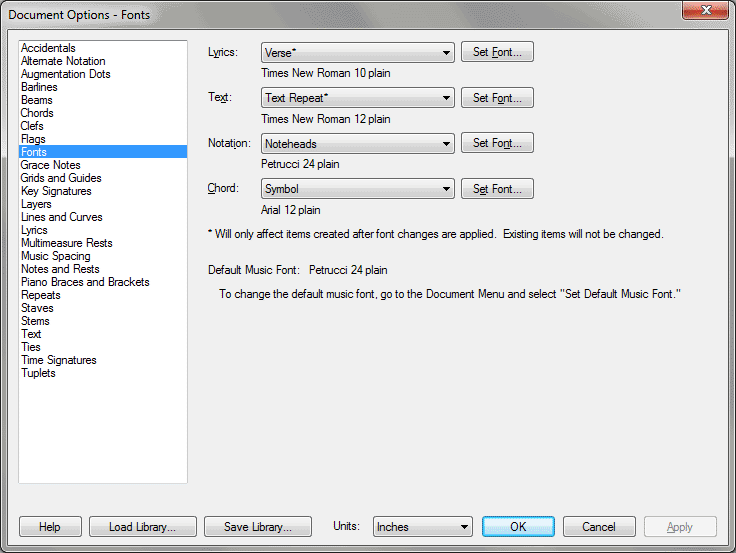Document Options-Fonts dialog box

How to get there
Choose Document > Document
Options and select Fonts.
What it does
These options allow you to globally change
the font for almost every element in your score. It lets you change all
occurrences at once, or set the primary font to the one you most often
use. Set the initial font for full and abbreviated staff names and group
names. Choose a name item from the drop-down list, then click Set Font
to specify the initial font for full and abbreviated staff names and group
names. This font is used when you first create a name. Use the Chord drop-down
list where you can specify separate fonts and sizes for chord roots and
chord suffixes, and setting the baseline positioning of sharps, flats
and naturals that appear on some chord roots. Maestro, a music font provided
with Finale, is the default font for the musical symbol elements such
as Music, Clef, Key, and Time. However, Finale offers you the option of
setting these musical elements in any other music fonts, such as Engraver,
Jazz, Petrucci (also provided), Sonata or Crescendo you can mix and match
fonts to suit your taste.
- Font
display. The font, size and style specified for an item appears
below the selected item, so you can see what font is selected without
entering the Font dialog box.
- Lyrics:
Verse • Chorus • Section; Set Font. Choose this command, then click
Set Font to specify the default font, size and style for Lyrics. These
three types of lyrics are technically identical, as far as Finale is concerned,
except that each type may have its own default font. (When you enter the
text for lyrics, use the Set Font button in the Lyrics window to
specify variations from the primary font.)
- Text: Text Repeat • Ending Repeat • Text Block • Measure Number
• Staff Names (Full) • Staff Names (Abbreviated) • Group Names (Full)
• Group Names (Abbreviated); Set Font. Choose this command, then click
Set Font to choose the default font, size and style of various text elements.
- Choose Text Repeats to specify the primary
(default) font for these text repeats, such as Fine,
that you create.
- Choose Ending Repeat to specify the primary
(default) font for the text under a repeat barline bracket ("1,2,3,",
for example, or "Repeat and fade").
- Choose Text Block to specify the primary (default)
font for text blocks.
- Choose Measure Number then click Set Font to
set the initial font for measure numbers in this dialog box. (You can
still change the fonts for each measure number region in the Measure Number
Map for Region dialog box.). The fonts you select for full staff names
and full group names will also be used for the default, non-printing staff
and group names.
Note: Define default fonts for expression categories in the Category Designer dialog box.
- Notation:
Noteheads • Percussion Noteheads • Tablature • Augmentation Dot • Accidentals • Flags • Rests • Clef • Key
• Time • Time Signature Plus Sign • Alternate Notation • Alternate Notation
Number • Repeat Dot • Multimeasure Rest • Tuplet • Articulation;
Set Font. You can separately define a different font for each music element—notes,
flags, rests and so on. Use the drop-down list to set the font for each
item. There’s also an option for setting the initial font for articulations
and the number displayed over multimeasure rests. Choose a notation type,
then click Set Font to choose the font, size and style for the element.
- Chord:
Symbol • Suffix • Alteration • Fretboard; Set Font. Items in the
Chord drop-down list include Alteration and Symbol, Suffix and Fretboard.
Suffix allows you to specify separate fonts, sizes and styles for chord
roots and chord suffixes. This will ensure correct font and character
spacing when you enter new chords directly into the score using Finale’s
Type Into Score method.
- Chord
Alteration Baseline Adjustment: Sharps • Flats • Naturals. Use
these controls to set baseline values individually for sharp signs, flat
signs and naturals placed on chord suffixes. To set the vertical distance
of sharps, flats and naturals from the baseline, enter a value in each
text box. Double sharps will use the offset for sharps and double flats
will use the offset for flats.
See Also:
Fonts
Font
Annotation
Staff Attributes dialog box
Measure Attributes dialog box
Document
menu/Document Options

